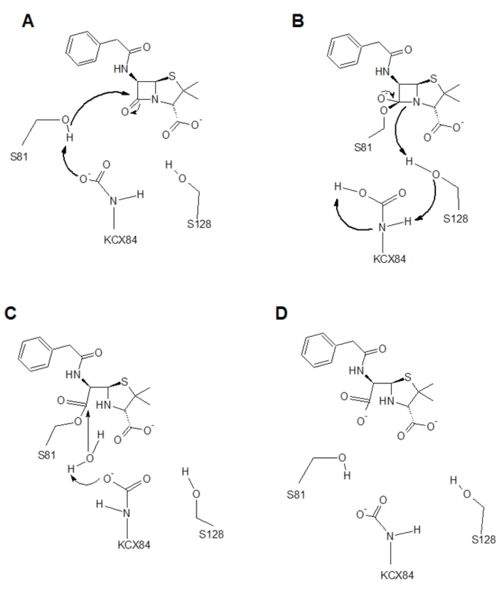Sandbox Reserved 994
From Proteopedia
(Difference between revisions)
| Line 20: | Line 20: | ||
== Structure == | == Structure == | ||
| - | OXA-24 is a monomeric protein with an active site composed of a short α-helix and a β-sheet. The active site of OXA-24 is characterized by a hydrophobic pocket, which is representative of Class D β-lactamases as a whole. The hydrophobic bridge contributes to the substrate specificity for carbapenems and is composed of an arrangement of the Tyr-112 and Met-223 side chains.<ref name="Santillana">PMCID: PMC1838445</ref> These residues block the active site and only allow a very specific binding configuration of antibiotics. The active site is overall positively charged and contains a sulfate ion along with other solvent molecules when no substrate is bound. The mechanism of attack is through the use of three catalytic residues: Serine-81, Carboxylated Lysine-84, and Serine-128. <scene name='69/691536/Catalytic_residues_oxa24/1'>Catalytic Residues</scene> The hydroxyl chain of Ser-128 conforms in the direction of the active-serine Ser-81, and contributes to the catalytic mechanism.<ref name="Santillana" /> | + | OXA-24 is a monomeric protein with an active site composed of a short α-helix and a β-sheet. The active site of OXA-24 is characterized by a hydrophobic pocket, which is representative of Class D β-lactamases as a whole. The hydrophobic bridge contributes to the substrate specificity for carbapenems and is composed of an arrangement of the Tyr-112 and Met-223 side chains.<ref name="Santillana">PMCID: PMC1838445</ref> <scene name='69/691536/Oxa24_bridge/1'>Bridge</scene> These residues block the active site and only allow a very specific binding configuration of antibiotics. The active site is overall positively charged and contains a sulfate ion along with other solvent molecules when no substrate is bound. The mechanism of attack is through the use of three catalytic residues: Serine-81, Carboxylated Lysine-84, and Serine-128. <scene name='69/691536/Catalytic_residues_oxa24/1'>Catalytic Residues</scene> The hydroxyl chain of Ser-128 conforms in the direction of the active-serine Ser-81, and contributes to the catalytic mechanism.<ref name="Santillana" /> |
== Hydrolysis Mechanism == | == Hydrolysis Mechanism == | ||
Revision as of 17:20, 27 February 2015
| This Sandbox is Reserved from 20/01/2015, through 30/04/2016 for use in the course "CHM 463" taught by Mary Karpen at the Grand Valley State University. This reservation includes Sandbox Reserved 987 through Sandbox Reserved 996. |
To get started:
More help: Help:Editing |
OXA-24 β-lactamase
| |||||||||||
References
- ↑ Hanson, R. M., Prilusky, J., Renjian, Z., Nakane, T. and Sussman, J. L. (2013), JSmol and the Next-Generation Web-Based Representation of 3D Molecular Structure as Applied to Proteopedia. Isr. J. Chem., 53:207-216. doi:http://dx.doi.org/10.1002/ijch.201300024
- ↑ Herraez A. Biomolecules in the computer: Jmol to the rescue. Biochem Mol Biol Educ. 2006 Jul;34(4):255-61. doi: 10.1002/bmb.2006.494034042644. PMID:21638687 doi:10.1002/bmb.2006.494034042644
- ↑ Bauman, Robert W. "Controlling Microbial Growth in the Body: Antimicrobial Drugs." In Microbiology with Diseases by Taxonomy, 287-288. 4th ed. Glenview, IL: Pearson, 2014.
- ↑ Bauman, Robert W. "Controlling Microbial Growth in the Body: Antimicrobial Drugs." In Microbiology with Diseases by Taxonomy, 299. 4th ed. Glenview, IL: Pearson, 2014.
- ↑ 5.0 5.1 Bou, German, Antonio Oliver, and Jesus Martinez-Beltran. "OXA-24, a Novel Class D β-Lactamase with Carbapenemase Activity in an Acinetobacter Baumannii Clinical Strain." Antimicrobial Agents and Chemotherapy 44, no. 6 (2000): 1556-561. Accessed February 19, 2015. http://aac.asm.org/content/44/6/1556.full
- ↑ Dijkshoorn, Lenie, Alexandr Nemec, and Harald Seifert. "An Increasing Threat in Hospitals: Multidrug-resistant Acinetobacter Baumannii." Nature Reviews Microbiology 5, no. 12 (2007): 939-51. Accessed February 19, 2015. http://www.nature.com/nrmicro/journal/v5/n12/full/nrmicro1789.html
- ↑ 7.0 7.1 7.2 7.3 7.4 7.5 Leonard DA, Bonomo RA, Powers RA. Class D beta-lactamases: a reappraisal after five decades. Acc Chem Res. 2013 Nov 19;46(11):2407-15. doi: 10.1021/ar300327a. Epub 2013 Jul, 31. PMID:23902256 doi:http://dx.doi.org/10.1021/ar300327a
- ↑ doi: https://dx.doi.org/10.3390/antibiotics3020128#sthash.iyPihLj1.dpuf
- ↑ PMCID: PMC162717
- ↑ Patrick, G. (2005). Antibacterial Agents. An Introduction to Medicinal Chemistry (3rd Ed), pages 388-414.
- ↑ Meroueh, S.O; Minasov, G; Lee, W; Shoichet, B.K; Mobashery, S. Structural aspects for evolution of beta-lactamases from penicillin-binding proteins. J. Am. Chem Soc. (2003), 125, 9612-9618.
- ↑ Neu, Harold. "The Crisis in Antibiotic Resistance." Science (1992) 257, 5073. ProQuest Medical Library: p. 1064-1072.
- ↑ Bush K, Jacoby GA. Updated functional classification of beta-lactamases. Antimicrob Agents Chemother. 2010 Mar;54(3):969-76. doi: 10.1128/AAC.01009-09., Epub 2009 Dec 7. PMID:19995920 doi:http://dx.doi.org/10.1128/AAC.01009-09
- ↑ 14.0 14.1 PMCID: PMC1838445
- ↑ Bou G, Oliver A, Martinez-Beltran J. OXA-24, a novel class D beta-lactamase with carbapenemase activity in an Acinetobacter baumannii clinical strain. Antimicrob Agents Chemother. 2000 Jun;44(6):1556-61. PMID:10817708


